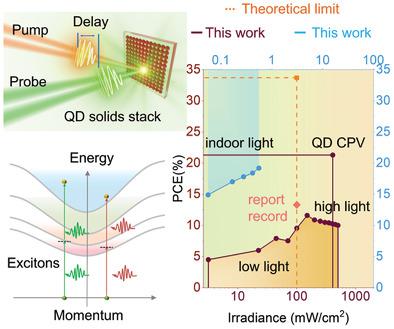当前位置:
X-MOL 学术
›
Adv. Funct. Mater.
›
论文详情
Our official English website, www.x-mol.net, welcomes your
feedback! (Note: you will need to create a separate account there.)
Multiphoton Absorption Stimulated Metal Chalcogenide Quantum Dot Solar Cells under Ambient and Concentrated Irradiance
Advanced Functional Materials ( IF 18.5 ) Pub Date : 2020-08-11 , DOI: 10.1002/adfm.202004563 Bo Hou 1 , Byung‐Sung Kim 2 , Harrison Ka Hin Lee 3 , Yuljae Cho 4 , Paul Giraud 2 , Mengxia Liu 5 , Jingchao Zhang 6 , Matthew L. Davies 3 , James R. Durrant 3, 7 , Wing Chung Tsoi 3 , Zhe Li 8 , Stoichko D. Dimitrov 9 , Jung Inn Sohn 10 , SeungNam Cha 11 , Jong Min Kim 12
Advanced Functional Materials ( IF 18.5 ) Pub Date : 2020-08-11 , DOI: 10.1002/adfm.202004563 Bo Hou 1 , Byung‐Sung Kim 2 , Harrison Ka Hin Lee 3 , Yuljae Cho 4 , Paul Giraud 2 , Mengxia Liu 5 , Jingchao Zhang 6 , Matthew L. Davies 3 , James R. Durrant 3, 7 , Wing Chung Tsoi 3 , Zhe Li 8 , Stoichko D. Dimitrov 9 , Jung Inn Sohn 10 , SeungNam Cha 11 , Jong Min Kim 12
Affiliation

|
Colloidal metal chalcogenide quantum dots (QDs) have excellent quantum efficiency in light–matter interactions and good device stability. However, QDs have been brought to the forefront as viable building blocks in bottom‐up assembling semiconductor devices, the development of QD solar cell (QDSC) is still confronting considerable challenges compared to other QD technologies due to their low performance under natural sunlight, as a consequence of untapped potential from their quantized density‐of‐state and inorganic natures. This report is designed to address this long‐standing challenge by accessing the feasibility of using QDSC for indoor and concentration PV (CPV) applications. This work finds that above bandgap photon energy irradiation of QD solids can generate high densities of excitons via multi‐photon absorption (MPA), and these excitons are not limited to diffuse by Auger recombination up to 1.5 × 1019 cm−3 densities. Based on these findings, a 19.5% (2000 lux indoor light) and an 11.6% efficiency (1.5 Suns) have been facilely realized from ordinary QDSCs (9.55% under 1 Sun). To further illustrate the potential of the MPA in QDSCs, 21.29% efficiency polymer lens CPVs (4.08 Suns) and viable sensor networks powered by indoor QDSCs matrix have been demonstrated.
中文翻译:

环境光和集中辐射下的多光子吸收激发金属硫属化物量子点太阳能电池
胶态金属硫族化物量子点(QD)在光-物质相互作用中具有出色的量子效率,并具有良好的器件稳定性。然而,量子点已成为自下而上组装半导体器件的可行构建基石,与其他量子点技术相比,量子点太阳能电池(QDSC)的开发仍面临着巨大的挑战,因为它们在自然阳光下的性能低下。由于其量化的状态密度和无机性质而未开发的潜力的结果。本报告旨在通过探讨在室内和集中式PV(CPV)应用中使用QDSC的可行性来应对这一长期挑战。这项工作发现,在QD固体的带隙以上光子能量辐照下,可以通过多光子吸收(MPA)产生高密度的激子,19 cm -3密度。基于这些发现,已经从普通QDSC轻松实现了19.5%(2000 lux室内照明)和11.6%效率(1.5 Sun)的转换(在1 Sun下为9.55%)。为了进一步说明MPA在QDSC中的潜力,已经证明了21.29%效率的聚合物透镜CPV(4.08太阳)和由室内QDSC矩阵提供动力的可行传感器网络。
更新日期:2020-09-25
中文翻译:

环境光和集中辐射下的多光子吸收激发金属硫属化物量子点太阳能电池
胶态金属硫族化物量子点(QD)在光-物质相互作用中具有出色的量子效率,并具有良好的器件稳定性。然而,量子点已成为自下而上组装半导体器件的可行构建基石,与其他量子点技术相比,量子点太阳能电池(QDSC)的开发仍面临着巨大的挑战,因为它们在自然阳光下的性能低下。由于其量化的状态密度和无机性质而未开发的潜力的结果。本报告旨在通过探讨在室内和集中式PV(CPV)应用中使用QDSC的可行性来应对这一长期挑战。这项工作发现,在QD固体的带隙以上光子能量辐照下,可以通过多光子吸收(MPA)产生高密度的激子,19 cm -3密度。基于这些发现,已经从普通QDSC轻松实现了19.5%(2000 lux室内照明)和11.6%效率(1.5 Sun)的转换(在1 Sun下为9.55%)。为了进一步说明MPA在QDSC中的潜力,已经证明了21.29%效率的聚合物透镜CPV(4.08太阳)和由室内QDSC矩阵提供动力的可行传感器网络。


















































 京公网安备 11010802027423号
京公网安备 11010802027423号